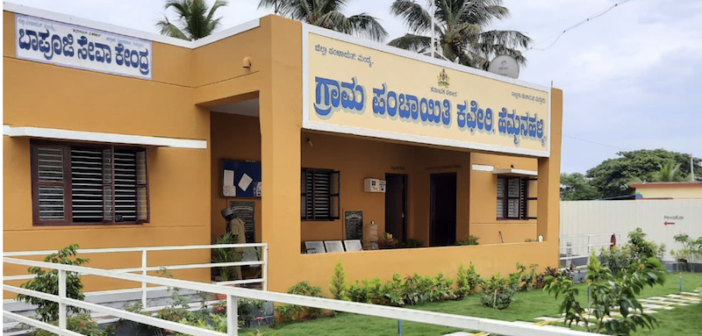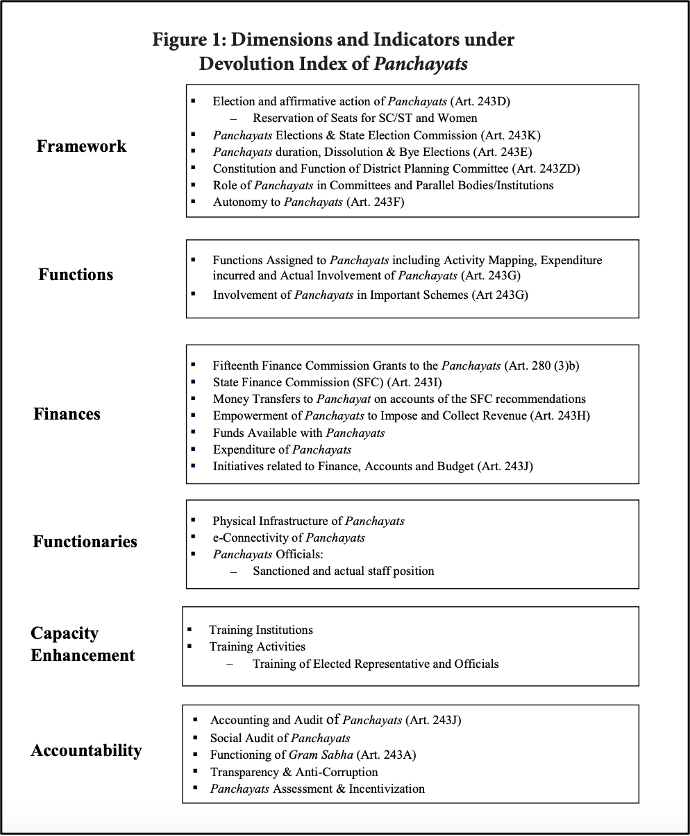The Ministry of Panchayati Raj recently in February 2025 released the report titled “Status of Devolution to Panchayats in States – An Indicative Evidence-Based Ranking”. In the report, States/UTs have been ranked according to the overall Panchayat devolution index as well as by each of the individual six dimensions. Here is a review.
Panchayats, as rural local self-government institutions, form a crucial pillar of India’s multi-order federal system, with their authority derived from the State. Recognizing the need for a structured framework for decentralized governance, the 73rd Constitutional Amendment Act of 1992 granted Panchayati Raj Institutions (PRIs) constitutional status, ensuring direct elections, financial devolution, and administrative autonomy. This amendment, enshrined in Part IX of the Constitution, aimed to empower local governance by defining their functions, establishing a three-tier system, and mandating reservations for marginalized communities and women. However, despite these constitutional provisions, the effective devolution of power remained a challenge, necessitating further institutional mechanisms to strengthen Panchayats.
To enhance devolution, the Ministry of Panchayati Raj (MoPR) initiated several measures, including Roundtables of Ministers in 2004 and the Devolution Index to assess states’ progress. The Panchayats Empowerment and Accountability Incentive Scheme (PEAIS), launched in 2005-06, further encouraged states to empower Panchayats while promoting transparency and accountability. Over the years, various institutions—including the National Council of Applied Economic Research (NCAER), the Indian Institute of Public Administration (IIPA), and the Tata Institute of Social Sciences (TISS)—have contributed to refining the Devolution Index and assessing states’ progress. The framework expanded beyond the initial “4Fs” (Framework, Functions, Finances, and Functionaries) to include Capacity Building and Accountability, ensuring a more comprehensive evaluation of Panchayati Raj Institutions.
Devolution index studies have improved over the years
In 2022, after a seven-year gap, the MoPR once again entrusted the IIPA to conduct a field assessment of devolution across states and Union Territories. The study evaluates the transfer of functions, functionaries, and finances to Panchayats, their role in managing local governance institutions, and their involvement in Centrally Sponsored Schemes. The methodology, built upon previous Devolution Index studies, incorporates inputs from state governments, experts, and local governance reports to ensure a data-driven, evidence-based ranking of Panchayat performance.
The Ministry recently in February 2025 released the report titled “Status of Devolution to Panchayats in States – An Indicative Evidence-Based Ranking”. In the report, States/UTs have been ranked according to the overall Panchayat devolution index as well as by each of the following six dimensions. The weightage given to each of the dimensions for the calculation of the overall dimension score (out of 100) has been given in the parenthesis.
- Framework (10): This dimension checks states’ compliance with mandatory constitutional requirements for Panchayati Raj before assessing their implementation.
- Functions (15): This evaluates the powers and responsibilities assigned to Panchayats under Article 243G.
- Finances (30): The dimension measures Panchayats’ financial autonomy and stability, focusing on revenue sources, fund transfers, expenditure, and budget management.
- Functionaries (15): This dimension is used to assess Panchayats’ infrastructure, e-connectivity, staff strength, and officials to gauge their administrative capacity.
- Capacity Enhancement (15): It evaluates state efforts to strengthen Panchayats through training institutions and capacity-building programs for elected representatives and officials.
- Accountability (15): Panchayats’ transparency, audits, social oversight, and anti-corruption measures to ensure fair and efficient governance have been assessed in this dimension.
The indicators considered for each dimension are as follows:
The study excludes Meghalaya, Mizoram, and Nagaland (where Part IX does not apply), Delhi (where Panchayats were superseded in 1990), and Chandigarh (where Panchayats do not exist). Data was collected for all states except Arunachal Pradesh and Manipur (due to unrest in Manipur). Among Union Territories, Lakshadweep, Dadra & Nagar Haveli and Daman & Diu did not provide updated data.
There has been an overall improvement in devolution score between 2013-14 and 2021-22
The overall score for devolution has increased from 39.9% to 43.9% between the period 2013-14 to 2021-22. This improvement can be attributed to the improvement in financial devolution which has risen from 32.05 to 37.04 during this period. However, the functional devolution—which determines the actual powers of Panchayat’s score has decreased. This is concerning since financial resources alone are ineffective without sufficient decision-making powers. On a positive note, accountability has slightly improved, while functionaries and capacity enhancement have seen significant growth.
Karnataka, Kerala and Tamil Nadu are the best-performing states
Based on the overall Devolution Index (DI) of states, Karnataka ranks first with a score of 72.23 followed by Kerala (70.59), Tamil Nadu (68.38), Maharashtra (61.44) and Uttar Pradesh (60.07). On the other side, Goa and Haryana have a score less than 40 while Jharkhand and Punjab have a score below 30. A significant gap is evident not only between the top-performing states and the poor ones but also between the top three states and the rest among the top 5. Northeastern states and UTs have a lower score.
Telangana and Goa have a good score in ‘capacity enhancement’ dimension
Karnataka ranks among the top three states across all devolution dimensions except capacity enhancement. Interestingly, Telangana, despite having a low overall Devolution Index, leads in capacity enhancement with a score of 86.19. Goa also ranks among the top 10 in this category. However, Goa has the lowest score (6.63) in functions, while Punjab ranks lowest in functionaries (8.2). Notably, the score of the top 10 states in ‘finances’ (the most decisive measurement of the six) and ‘functions’ is low, in the range of 60s. The top 10 states in the dimensions of capacity enhancement and accountability exceed 80 points.
Recommendations made for improvement in each dimension
The report makes important recommendations focusing on enhancing the role, efficiency, and effectiveness of Panchayats as institutions of self-governance, aimed at deepening democracy and ensuring better resource mobilization and people’s participation in development. The suggestions span across the six dimensions.
With respect to the ‘Framework’ dimension, the recommendations suggest freezing reserved seats in Panchayat elections for several terms to ensure stable leadership and effective performance. They advocate for vesting the State Election Commissions (SEC) with full authority over election-related matters to prevent political interference and ensure timely and fair elections. A common electoral roll is proposed to avoid confusion and duplication. Funding for SECs should be assured to support their operational needs. The role of District Planning Committees needs to be strengthened to ensure comprehensive grassroots planning.
The recommendations to improve ‘Functions’ dimension emphasize the importance of integrating Panchayats into Central Sector Schemes (CSS) by transferring funds directly to them instead of parallel bodies. They suggest enhancing monitoring and mentoring for CSS implementation to ensure uniformity across states. The Gram Panchayat Development Plan (GPDP) should serve as a central document guiding all developmental activities to improve resource mobilization.
With regards to the ‘Finance’ dimension, the report calls for constitutional amendments to recognize Panchayats in fiscal architecture, ensuring timely and adequate financial transfers. State Finance Commissions (SFC) should be mandated to function with more regularity and seriousness. Panchayats should be empowered to levy property taxes, and the use of Public Financial Management Systems (PFMS) should be made mandatory for all financial transactions to ensure transparency and accountability.
To improve the functioning of Panchayats (‘Functionaries’), the recommendations suggest increasing manpower. They propose establishing separate recruitment bodies for Panchayat employees and creating a link between Panchayat and State cadre employees to ensure career progression and merit-based promotions.
With respect to ‘Capacity enhancement’ dimension, it recommended investment in training infrastructure and programs to equip Panchayat members and officials with the necessary skills. A comprehensive curriculum for Local Public Service Management and the use of IT applications for monitoring capacity-building activities are recommended.
To improve ‘Accountability’, the recommendations highlight the need for clear rules and regulations for Panchayats to operate as facilitators of self-governance. They suggest appointing Local Government Ombudsmen. Periodic Panchayat surveys and performance evaluations are proposed to monitor progress and ensure accountability to residents.
Overall, the report suggested measures to strengthen Panchayats by ensuring administrative and financial autonomy, enhancing their functional roles, improving capacity, and fostering accountability. They also emphasize the need for gender sensitization, environmental awareness, and disaster management capabilities within Panchayats.




